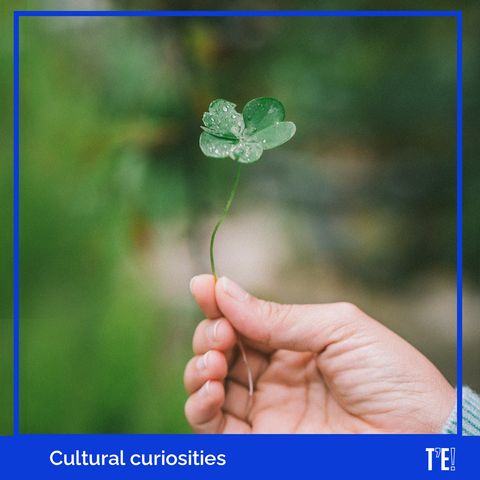Hello and welcome to this podcast brought to you by That's English!, the Spanish Ministry of Education's official distance learning English course. To find out more about That's English! go to www.thatsenglish.com or contact your local Official School of Languages Welcome to the second part of this podcast about St. Patrick's Day. Today we are going to talk about St. Patrick's Day traditions and how this festivity is celebrated in Ireland and the United States. One of the most important symbols of St. Patrick's Day is the shamrock, which is a type of clover, and which people wear as a badge on the lapel. St. Patrick used this plant to explain the Holy Trinity and is often represented holding a shamrock. At the beginning of the twentieth century, the shamrock lost its religious significance to become a symbol of good luck and, nowadays, on St. Patrick's Day, people exchange good wish cards with shamrocks. Another tradition of St. Patrick's Day is that everybody wears green. Contrary to popular belief, the colour associated with St. Patrick is in fact blue, as can be seen in several artworks depicting the saint. Indeed, in King Henry VIII's time, the Irish flag was blue with a golden harp. The association of the colour green with Ireland and Irishness developed later and began in 1798 with the Irish Rebellion, which was an uprising against British rule when the shamrock and the colour green became symbols of Irish nationalism. This probably arose from the association with the greenness of the Irish landscape, which gives the country the name of the Emerald Isle. Wearing green on St. Patrick's Day is considered to be a tribute to Ireland and is also a symbol of good luck. For more than fifty years, in the City of Chicago, the river is dyed a bright emerald green in honour of St. Patrick and in Ireland and in the US, anyone who doesn't wear green on the day is likely to end up being pinched. The association of the colour green with Ireland also transformed the garments of the most famous creature in Irish folklore: the leprechaun who, apparently, originally wore red clothes, though other theories say that these little creatures could camouflage themselves in the Irish countryside much better if they wore green. You will see many people wearing leprechaun hats on St. Patrick's Day even though, according to folklore, the true leprechauns are rarely seen. They are said to be very wealthy creatures who hide their pots of gold at the end of a rainbow. So what do people eat on St. Patrick's Day? Well, corned beef and cabbage is the obvious answer. But, in fact, this is an Irish-American tradition. In Ireland itself, people are more likely to eat different kinds of sausage: white pudding made from minced pig's liver, black pudding made from blood, meat, oatmeal and bread and Irish bacon, taken from the back of the pig instead of the belly. As regards cabbage, which the Celts are believed to have introduced into Europe from Asia around 600 BC, it is probably the vegetable Ireland is most famous for, along with potatoes, of course. So what is corned beef and how did it become so popular? When the Irish arrived in New York City they settled on the Lower Side next to the Jewish Quarter where they could buy cheap corned beef made by their Jewish neighbours. The name corned beef comes from the 'corns' or pellets of salt which were used to cure the meat. On St. Patrick's Day, the corned beef is braised in water with sugar, vinegar and salt for 3 hours. The cabbage is boiled in the liquid that is left over after the meat is cooked. Nothing is wasted. The corned beef and the cabbage are then served with Irish soda bread, made with sodium bicarbonate, instead of yeast, to make the bread rise, as yeast was an expensive commodity for the Irish immigrants. Another traditional dish is of course Irish stew, which should be made with lamb chops, potatoes, carrots, onions, thyme and fresh parsley, all of which should be washed down with a pint of beer with green dye in the States or a Guinness, probably the most Irish symbol of all today. In fact, this Irish stout beer, which dates back to the 1750s, is still the most popular alcoholic drink in Ireland. Finally, no St. Patrick's Day celebration would be complete without Irish folk music. Popular Irish songs that you will probably hear are: "Finnegan's Wake", "Whiskey in the Jar", "The Wild Rover" and "Molly Malone", played on the fiddle, the tin whistle, the banjo, the bagpipes, the bodhran and the harp which was adopted as the Irish national symbol when Ireland gained its independence in 1921. So whatever you do on 17th March, Happy St. Patrick's Day or as the Irish would say "Top o’ the mornin’ to ya." We hope you have enjoyed this podcast, brought to you by That's English! Please follow us on Facebook and Twitter. We look forward to hearing from you. Bye for now! Glossary: leprechaun - an elf-like creature in Irish folklore shamrock - a type of clover fiddle - a violin tin whistle - a small flute-like instrument made from a thin metal tube, with six finger holes of varying size on top and no thumb holes (OED) bodhrán - a shallow one-sided Irish drum played using a short stick (OED)
show less

